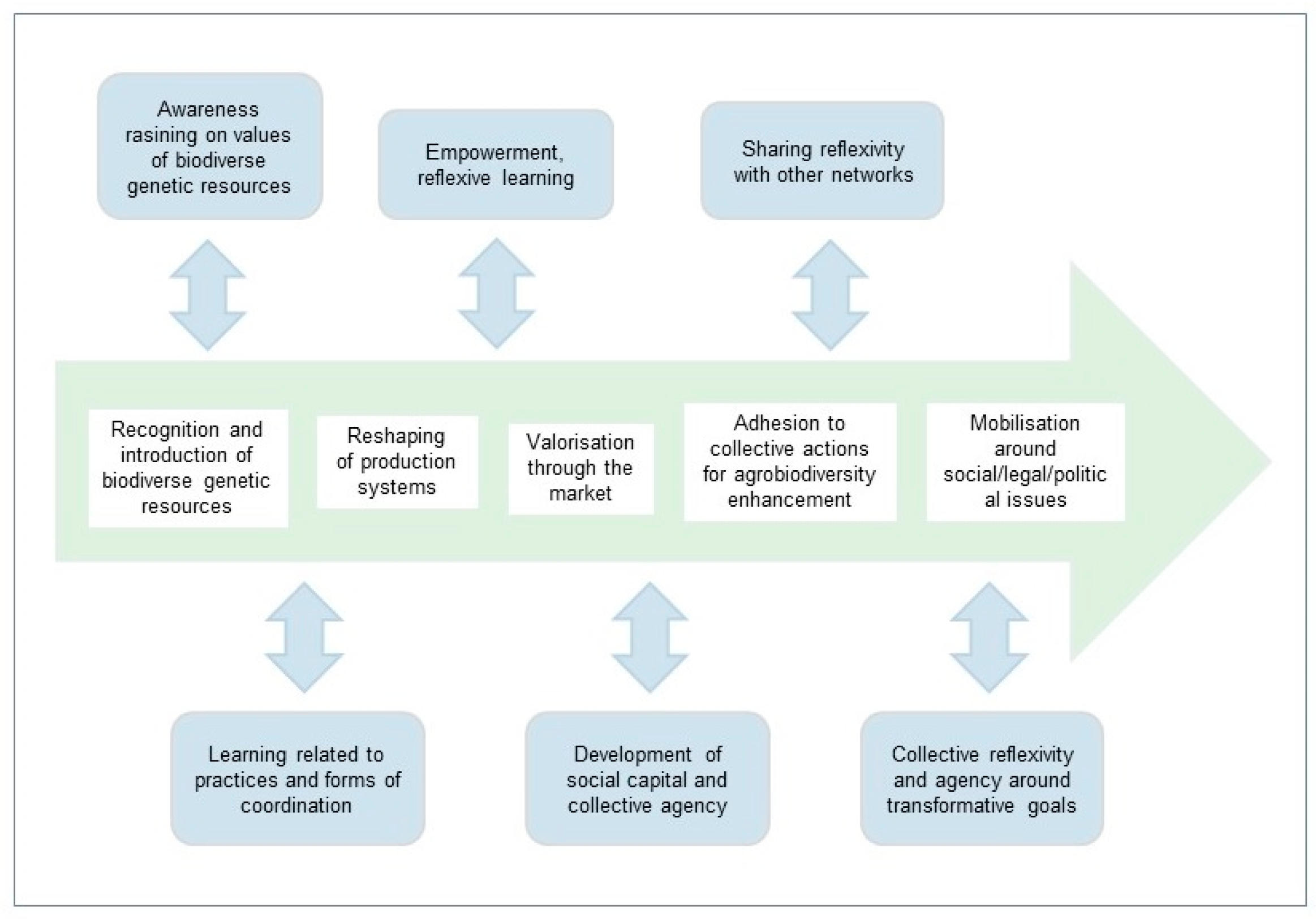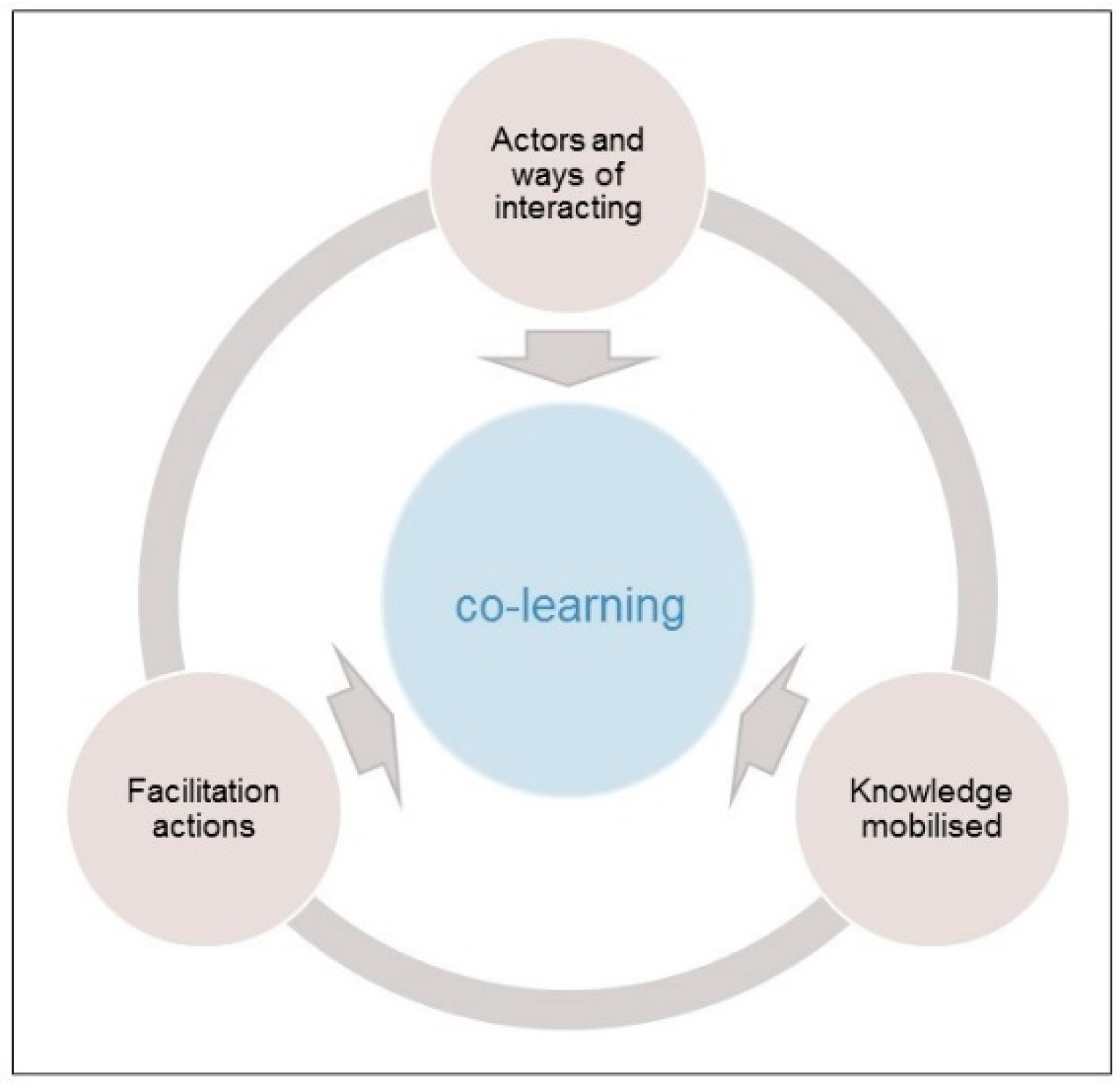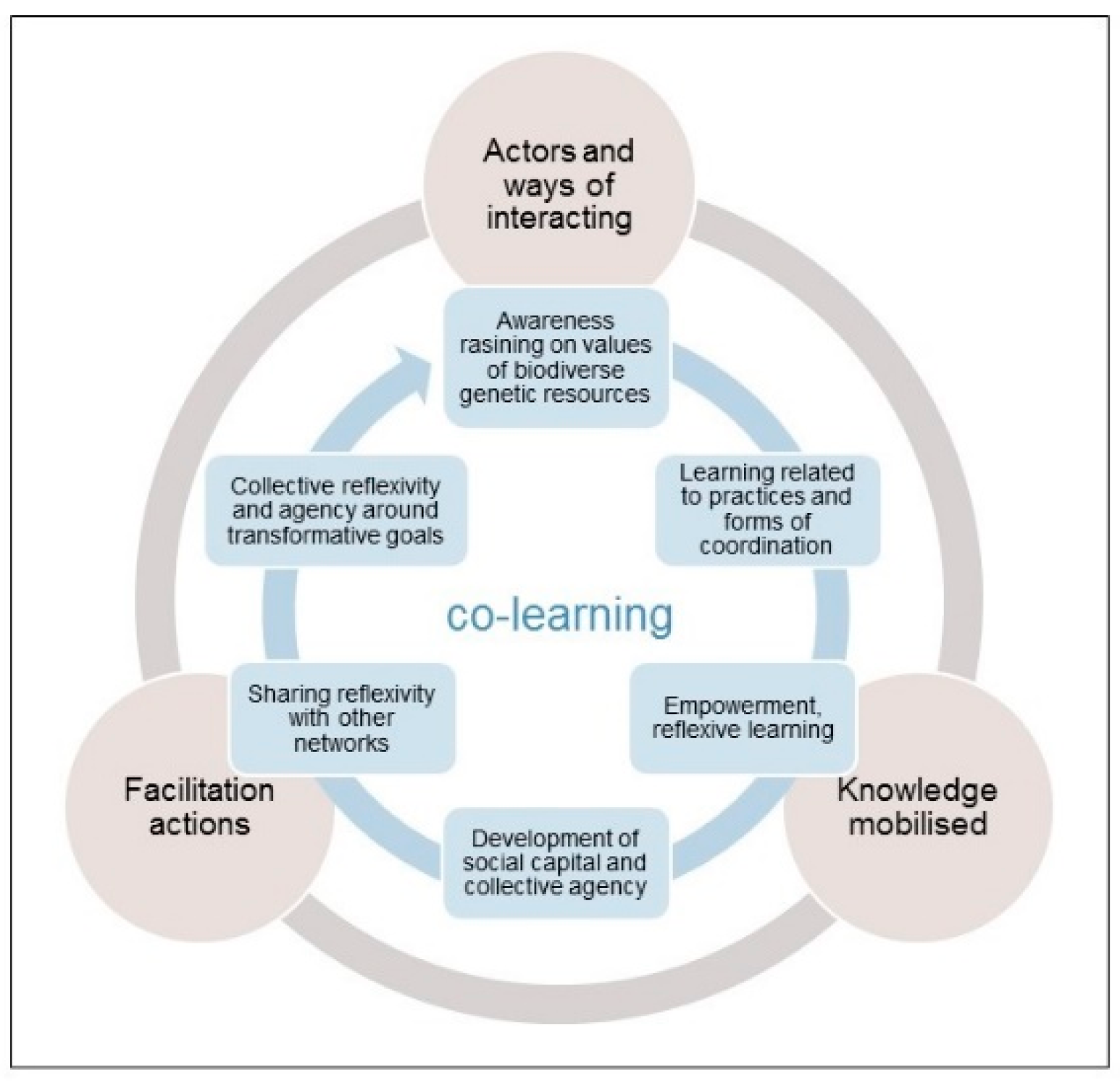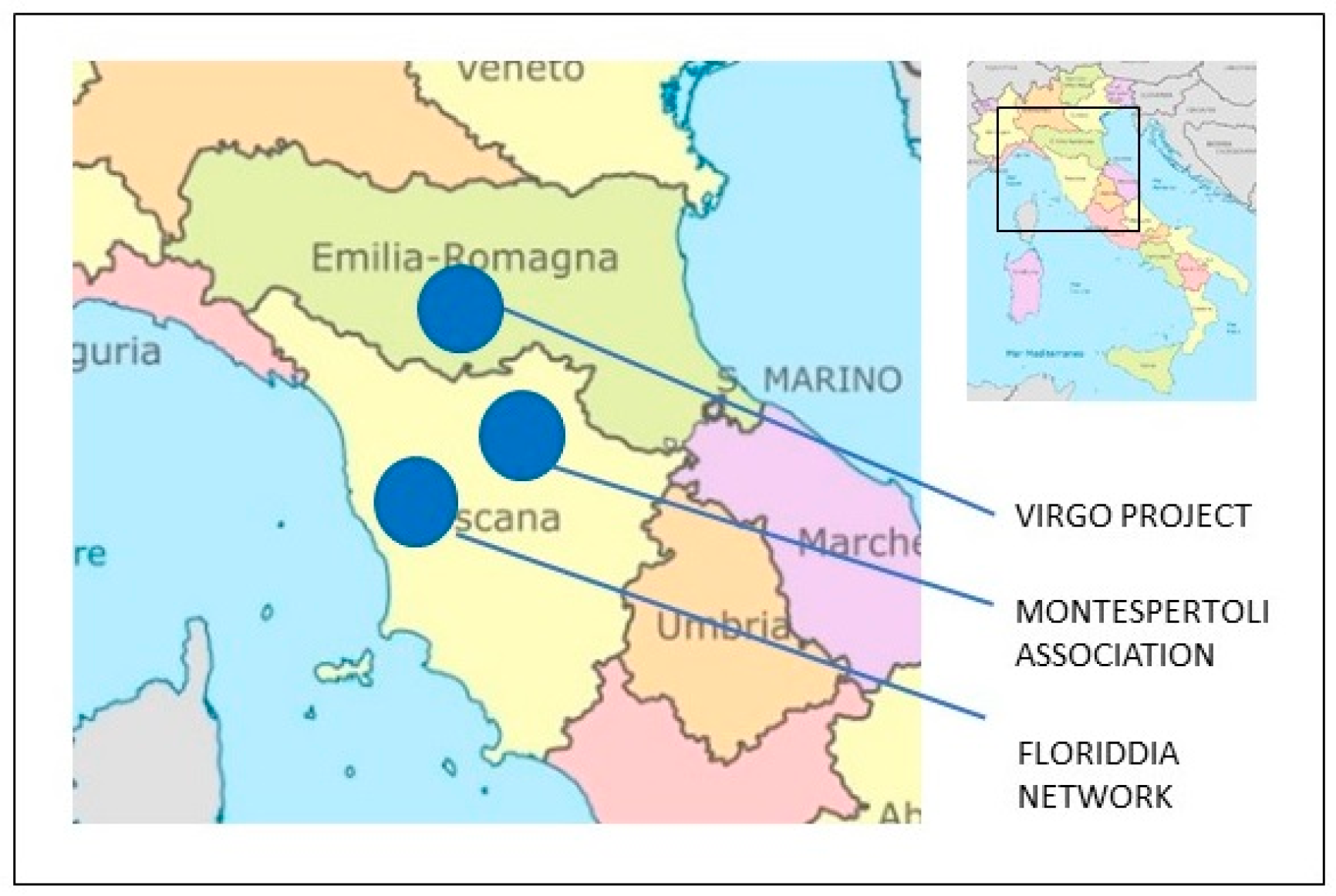From Co-Learning to Shared Commitment to Agroecology. Some Insights from Initiatives Aimed at Reintroducing Agrobiodiversity
Abstract
1. Introduction
2. Theoretical Background
3. Empirical Material, Methods and Analytical Framework
3.1. Subject of the Analysis
- recognition of the values of “biodiverse” genetic resources and their introduction into farming systems, facing the constraints posed by seed regulatory frameworks; to that end, creation/strengthening of horizontal connections among farmers (in many cases weakened by agricultural modernisation);
- re-shaping and re-organisation of production systems through: actions involving skills and technology in breeding, cultivation and processing; definition of appropriate forms of coordination and organisational models to optimise the relationships among supply chain actors;
- cultural and economic valorisation of biodiverse products through suitable market channels and appropriate forms of communication to foster acknowledgement and appreciation of the multiple values of diversity-based farming/food systems and related products; at the same time, fair economic value distribution along the supply chain to assure economic sustainability to each value chain stage;
- adhesion to collective actions of enhancement of agrobiodiversity, aimed at sharing experiences and promoting new initiatives; this can occur at local level or by interacting with broader networks;
- mobilisation around social-legal-political issues, going beyond the mere production sphere to address the challenges linked to building alternatives to the dominant system of genetic resource management.
3.2. Methodological Aspects
3.3. The Analytical Framework
- involvement of different actors and related ways of interacting, taking into consideration all the actors playing a role in the analysed processes and how they take part in these processes, including an evolution of their role and modes of interacting over time;
- knowledge mobilised, taking into consideration all types of pre-existing, shared and co-created knowledge (e.g., experiential, contextual, informal, scientific, codified);
- facilitation actions, carried out by actors institutionally recognised for their role of intermediation, but also by any other actor able to play such role.
4. The Studied Cases
4.1. The Floriddia Farm and Its Network
4.2. Heritage Wheats of Montespertoli Association
4.3. The Virgo Project
5. Analysis
5.1. Sharing and Co-creation of Knowledge in Understanding and Handling Agrobiodiversity
5.1.1. Recognition and Introduction of Biodiverse Genetic Resources
5.1.2. Reshaping Production Systems
5.1.3. Valorisation of Biodiverse Genetic Resources through the Market
5.1.4. Adhesion to Collective Actions and Further Mobilisation around Social/Legal/Political Issues
5.2. The Role of Modes of Interacting and of Facilitation
6. Towards a More Advanced Understanding of Knowledge Co-Creation and Facilitation
Funding
Acknowledgments
Conflicts of Interest
References
- Hinrichs, C.C. Transitions to sustainability: A change in thinking about food systems change? Agric. Hum. Values 2014, 31, 143–155. [Google Scholar] [CrossRef]
- Wezel, A.; Bellon, S.; Dorè, T.; Francis, C.; Vallod, D.; David, C. Agroecology as a science, a movement and a practice. A review. Agron. Sustain. Dev. 2009, 29, 503–515. [Google Scholar] [CrossRef]
- Gliessman, S. Agroecology: Growing the Roots of Resistance. Agroecol. Sustain. Food Syst. 2013, 37, 19–31. [Google Scholar]
- Francis, C.; Rickerl, D.; Lieblein, G.; Salvador, R.; Gliessman, S.; Wiedenhoeft, M.; Breland, T.A.; Simmons, S.; Creamer, N.; Allen, P.; et al. Agroecology: The ecology of food system. J. Sustain. Agric. 2003, 22, 99–118. [Google Scholar] [CrossRef]
- Mendez, V.E.; Bacon, C.M.; Cohen, R. Agroecology as a Transdisciplinary, Participatory, and Action-Oriented Approach. Agroecol. Sustain Food Syst. 2013, 37, 3–18. [Google Scholar]
- Gonzales De Molina, M. Agroecology and Politics. How to Get Sustainability? About the Necessity for a Political Agroecology. Agroecol. Sustain. Food Syst. 2013, 37, 45–59. [Google Scholar]
- FAO. The 10 Elements of Agroecology; FAO: Rome, Italy, 2018. [Google Scholar]
- Wakeford, T.; Anderson, C.; Charanya, R.; Pimbert, M. Strengthening people’s knowledge. Farm. Matters Mag. 2016, 32, 40–43. [Google Scholar]
- Levidow, L.; Pimbert, M.; Vanloqueren, G. Agroecological Research: Conforming—Or Transforming the Dominant Agro-Food Regime? Agroecol. Sustain. Food Syst. 2014, 38, 1127–1155. [Google Scholar] [CrossRef]
- Levidow, L. European transitions towards a corporate-environmental food regime: Agroecological incorporation or contestation? J. Rural. Stud. 2015, 40, 76–89. [Google Scholar] [CrossRef]
- Holt-Giménez, E.; Altieri, M. Agroecology “lite:” cooptation and resistance in the global north. Food First 2016, 38, 1–3. [Google Scholar]
- Pimbert, M.P. Food Sovereignty, Agroecology and Biocultural Diversity. Constructing and Contesting Knowledge; Routledge: London, UK, 2018. [Google Scholar]
- Schlosberg, D. Defining Environmental Justice: Theories, Movements, and Nature; Oxford University Press: New York, NY, USA, 2007. [Google Scholar]
- Walker, G. Environmental Justice. Concepts, Evidence and Politics, 1st ed.; Routledge: London, UK, 2012; Volume 272. [Google Scholar]
- Méndez, V.E.; Bacon, C.M.; Cohen, R.; Gliessman, S.R. Agroecology: A Transdisciplinary, Participatory and Action-Oriented Approach; CRC Press: Roca Baton, FL, USA, 2015. [Google Scholar]
- Coolsaet, B. Towards an agroecology of knowledges: Recognition, cognitive justice and farmers’ autonomy in France. J. Rural Stud. 2016, 47, 165–171. [Google Scholar] [CrossRef]
- Pimbert, M.P. Democratizing knowledge and ways of knowing for food sovereignty, agroecology and biocultural diversity. In Food Sovereignty, Agroecology and Biocultural Diversity. Constructing and Contesting Knowledge, 1st ed.; Pimbert, M.P., Ed.; Routledge: London, UK, 2018; pp. 231–259. [Google Scholar]
- Lamine, C. Transdisciplinarity in Research about Agrifood Systems Transitions: A Pragmatist Approach to Processes of Attachment. Sustainability 2018, 10, 1241. [Google Scholar] [CrossRef]
- Hazard, L.; Steyaert, P.; Martin, G.; Couix, N.; Navas, M.L.; Duru, M.; Lauvie, A.; Labatut, J. Mutual, learning between researchers and farmers during implementation of scientific principles for sustainable development: The case of biodiversity-based agriculture. Sustain. Sci. 2018, 13, 517–530. [Google Scholar] [CrossRef]
- Anderson, C.R.; Maughan, C.; Pimbert, M.P. Transformative agroecology learning in Europe: Building consciousness, skills and collective capacity for food sovereignty. Agric. Hum. Values 2019, 36, 531–547. [Google Scholar] [CrossRef]
- Chable, V.; Nuijten, E.; Costanzo, A.; Goldringer, I.; Bocci, R.; Oehen, B.; Rey, F.; Fasoula, D.; Feher, J.; Keskitalo, M.; et al. Embedding Cultivated Diversity in Society for Agro-Ecological Transition. Sustainability 2020, 12, 784. [Google Scholar] [CrossRef]
- Brunori, G.; Rossi, A.; D’amico, S. A Comprehensive and participatory approach to the valorisation of biodiverse products. In Food Diversity between Rights, Duties and Autonomies. Legal Perspectives for a Scientific Cultural and Social Debate on the Right to Food and Agroecology; Isoni, A., Troisi, M., Pierri, M., Eds.; LITES, 2; Springer International Publishing AG: Basel, Switzerland, 2018; pp. 3–22. [Google Scholar]
- Kloppenburg, J. Impeding Dispossession, Enabling Repossession: Biological Open Source and the Recovery of Seed Sovereignty. J. Agrar. Chang. 2010, 10, 367–388. [Google Scholar] [CrossRef]
- Bocci, R. Seeds between freedom and rights. Sci. Territ. 2014, 2, 115–121. [Google Scholar]
- Humphries, S.; Rosas, J.C.; Gomez, M. A farmer-NGO-scientist synergy. Farming Matters Mag. 2016, 3, 14–16. [Google Scholar]
- Rossi, A.; Bocci, R. The Transformative Potential of Social Innovation. The Case of Wheat and Bread Value Chain in Tuscany. Int. J. Soc. Agrar. Food 2018, 24, 431–448. [Google Scholar]
- Fehér, J.; Padel, S.; Rossi, A.; Drexler, D.; Oehen, B. Embedding Crop Genetic Diversity in Food Value Chains. Policy Recommendations from the Horizon 2020, Project Diversifood 2019, Booklet #5. Available online: http://www.diversifood.eu/wp-content/uploads/2017/09/Booklet5Diversifood_WEB.pdf (accessed on 4 June 2020).
- Bocci, R.; Chable, V. Peasant seeds in Europe: Stakes and prospects. J. Agric. Environ. Int. Dev. 2009, 103, 81–93. [Google Scholar]
- Demeulenaere, E. ‘Free our seeds!’ Strategies of farmers’ movements to reappropriate seeds. In The Commons, Plant Breeding and Agricultural Research. Challenges for Food Security and Agrobiodiversity; Girard, F., Frison, C., Eds.; Routledge: London, UK, 2018; pp. 210–225. [Google Scholar]
- Knickel, K.; Brunori, G.; Rand, S.; Proost, J. Towards a Better Conceptual Framework for Innovation Processes in Agriculture and Rural Development: From Linear Models to Systemic Approaches. J. Agric. Educ. Ext. 2009, 15, 131–146. [Google Scholar] [CrossRef]
- Elzen, B.; Barbier, M.; Cerf, M.; Grin, J. Stimulating transitions towards sustainable farming systems. In Farming Systems Research into the 21st Century: The New Dynamic; Darnhofer, I., Gibbon, D., Dedieu, B., Eds.; Springer: Heidelberg, Germany, 2012; pp. 431–455. [Google Scholar]
- Moschitz, H.; Roep, D.; Brunori, G.; Tisenkopfs, T. Learning and Innovation Networks for Sustainable Agriculture: Processes of Co-evolution, Joint Reflection and Facilitation. J. Agric. Educ. Ext. 2015, 21, 1–11. [Google Scholar] [CrossRef]
- Howells, J. Intermediation and the Role of Intermediaries in Innovation. Res. Policy 2006, 35, 715–728. [Google Scholar] [CrossRef]
- Kilelu, C.W.; Klerkx, L.; Leeuwis, C.; Hall, A. Beyond Knowledge Brokering: An Exploratory Study on Innovation Intermediaries in an Evolving Smallholder Agricultural System in Kenya. Knowl. Manag. Dev. J. 2011, 7, 84–108. [Google Scholar] [CrossRef]
- Klerkx, L.; van Mierlo, B.; Leeuwuis, C. Evolution of systems approaches to agricultural innovation: Concepts, analysis and interventions. In Farming Systems Research into the 21st Century: The New Dynamic; Darnhofer, I., Gibbon, D., Dedieu, B., Eds.; Springer: Berlin/Heidelberg, Germany, 2012; pp. 457–483. [Google Scholar]
- Klerkx, L.; Schut, M.; Leeuwis, C.; Kilelu, C. Advances in Knowledge Brokering in the Agricultural Sector: Towards Innovation System Facilitation. IDS Bull. 2012, 43, 53–60. [Google Scholar] [CrossRef]
- Seyfang, G.; Hielscher, S.; Hargreaves, T.; Martiskainen, M.; Smith, A. A grassroots sustainable energy niche? Reflections on community energy in the UK. Environ. Innov. Soc. Transit. 2014, 13, 21–44. [Google Scholar] [CrossRef]
- Tisenkopfs, T.; Kunda, I.; Šūmane, S.; Brunori, G.; Klerkx, L.; Moschitz, H. Learning and Innovation in Agriculture and Rural Development: The Use of the Concepts of Boundary Work and Boundary Objects. J. Agric. Educ. Ext. 2015, 21, 13–33. [Google Scholar] [CrossRef]
- Wezel, A.; David, C. Agroecology and the food system. In Agroecology and Strategies for Climate Change; Lichtfouse, E., Ed.; Sustainable Agriculture Reviews, 8; Springer: Dordrecht, The Netherlands, 2012; pp. 17–34. [Google Scholar]
- Wezel, A.; Brives, H.; Casagrande, M.; Clément, C.; Dufour, A.; Vandenbroucke, P. Agroecology territories: Places for sustainable agricultural and food systems and biodiversity conservation. Agroecol. Sustain. Food Syst. 2016, 40, 132–144. [Google Scholar] [CrossRef]
- Brunori, G.; Barjolle, D.; Dockes, A.C.; Helmle, S.; Ingram, J.; Klerkx, L.; Moschitz, H.; Nemes, G.; Tisenkopfs, T. CAP Reform and Innovation: The Role of Learning and Innovation Networks. Euro Choices 2013, 12, 27–32. [Google Scholar] [CrossRef]
- Tukker, A.; Butter, M. Governance of sustainable transitions; about the 4 ways to change the world. J. Clean. Prod. 2007, 15, 94–103. [Google Scholar] [CrossRef]
- Milgroom, J.; Bruil, J.; Leeuwis, C. Editorial—Co-creation in the practice, science and movement of agroecology. Farming Matters Mag. 2016, 32, 5–8. [Google Scholar]
- Mendez, V.E.; Bacon, C.M.; Cohen, R. Introduction: Agroecology. A Transdisciplinary, Participatory and Action-oriented Approach. In Agroecology. A Transdisciplinary, Participatory and Action-Oriented Approach; Mendez, V.E., Bacon, C.M., Cohen, R., Gliessman, S.R., Eds.; CRC Press: Boca Raton, FL, USA, 2016; pp. 1–22. [Google Scholar]
- Voß, J.P.; Kemp, R. Sustainability and reflexive governance: Introduction. In Reflexive Governance for Sustainable Development; Voß, J.P., Bauknecht, D., Kemp, R., Eds.; Edward Elgar Publishing: Cheltenham, UK, 2006; pp. 3–28. [Google Scholar]
- Popa, F.; Guillermin, M.; Dedeurwaerdere, T. A pragmatist approach to transdisciplinarity in sustainability research: From complex systems theory to reflexive science. Environ. Policy Gov. 2015, 25, 230–242. [Google Scholar] [CrossRef]
- Curry, N.; Kirwan, J. The role of tacit knowledge in developing networks for sustainable agriculture. Sociol. Rural. 2014, 54, 341–361. [Google Scholar] [CrossRef]
- Šūmane, S.; Kunda, I.; Knickel, K.; Strauss, A.; Tisenkopfs, T.; des los Rios, I.; Rivera, M.; Chebach, T.; Ashkenazy, A. Local and farmers’ knowledge matters! How integrating informal and formal knowledge enhances sustainable and resilient agriculture. J. Rural Stud. 2019, 59, 232–241. [Google Scholar] [CrossRef]
- Elzen, B.; Geels, F.W.; Leeuwis, C.; Van Mierlo, B. Normative contestation in transitions ‘in the making’: Animal welfare concerns and system innovation in pig husbandry. Res. Policy 2011, 40, 263–275. [Google Scholar] [CrossRef]
- Nuijten, E. Combining research styles of the natural and social sciences in agricultural research. NJAS Wagening. J. Life Sci. 2011, 57, 197–205. [Google Scholar] [CrossRef]
- Couix, N.; Hazard, L. When the future of biodiversity depends on researchers’ and stakeholders’ thought-styles. Futures 2013, 53, 13–21. [Google Scholar] [CrossRef]
- Levkoe, C.Z.; Brem-Wilson, J.; Anderson, C.R. People, power, change: Three pillars of a food sovereignty research praxis. J. Peasant Stud. 2019, 46, 1389–1412. [Google Scholar] [CrossRef]
- Beers, P.J.; Sol, J.; Wals, A. Social learning in a multi-actor innovation context. In Building Sustainable Rural Futures. The Added Value of Systems Approaches in Times of Change and Uncertainty, Proceedings of the 9th European International Farming Systems Association (IFSA) Symposium, Vienna, Austria, 4–7 July 2010; Darnhofer, I., Grötzer, M., Eds.; University of Natural Resources and Applied Life Sciences: Vienna, Austria; pp. 144–153.
- Sol, J.; Beers, J.P.; Wals, A.E.J. Social learning in regional innovation networks: Trust, commitment and reframing as emergent properties of interaction. J. Clean. Prod. 2013, 49, 35–43. [Google Scholar] [CrossRef]
- Visvanathan, S. Knowledge, justice and democracy. In Science and Citizens: Globalization and the Challenge of Engagement; Leach, M., Scoones, I., Wynne, B., Eds.; Zed Books: London, UK, 2005; pp. 83–94. [Google Scholar]
- Argyris, C.; Schön, D.A. Organizational Learning: A Theory of Action Perspective; Addison-Wesley: Reading, MA, USA, 1978. [Google Scholar]
- Kemp, R.; Schot, J.; Hoogma, R. Regime shifts to sustainability through processes of niche formation: The approach of Strategic Niche Management. Technol. Anal. Strat. Manag. 1998, 10, 175–1958. [Google Scholar] [CrossRef]
- Goffman, E. Frame Analysis: An Essay on the Organization of Experience; Harvard University Press: Cambridge, MA, USA, 1974. [Google Scholar]
- Benford, R.D.; Snow, D.A. Framing Processes and Social Movements: An Overview and Assessment. Annu. Rev. Sociol. 2000, 26, 611–639. [Google Scholar] [CrossRef]
- Tisenkopfs, T.; Kunda, I.; Šūmane, S. Learning as Issue Framing in Agricultural Innovation Networks. J. Agric. Educ. Ext. 2015, 20, 309–326. [Google Scholar] [CrossRef]
- Rip, A.; Kemp, R. Technological change. In Human Choice and Climate Change; Rayner, S., Malone, E.L., Eds.; Battelle Press: Columbus, OH, USA, 1998; Volume 2, pp. 327–399. [Google Scholar]
- Geels, F.W. Technological transitions as evolutionary reconfiguration processes: A multi-level perspective and a case-study. Res. Policy 2002, 31, 1257–1274. [Google Scholar] [CrossRef]
- Geels, F.; Schot, J. Typology of socio-technical transition pathways. Res. Policy 2007, 36, 399–417. [Google Scholar] [CrossRef]
- Geels, F.W. Ontologies, socio-technical transitions (to sustainability), and the multi-level perspective. Res. Policy 2010, 39, 495–510. [Google Scholar] [CrossRef]
- Grin, J.; Rotmans, J.; Schot, J.W. Transitions to Sustainable Development [Electronic Resource]: New Directions in the Study of Long-Term Transformative Change; Routledge: New York, NY, USA, 2010. [Google Scholar]
- Smith, A.; VOß, J.; Grin, J. Innovation studies and sustainability transitions: The allure of the multi-level perspective and its challenges. Res. Policy 2010, 39, 435–448. [Google Scholar] [CrossRef]
- Ingram, J.; Maye, D.; Kirwan, J.; Curry, N.; Kubinakova, K. Interactions between niche and regime: An analysis of learning and innovation networks for sustainable agriculture across Europe. J. Agric. Educ. Ext. 2015, 21, 55–71. [Google Scholar] [CrossRef]
- Wood, B.A.; Blair, H.T.; Gray, D.I.; Kemp, P.D.; Kenyon, P.R.; Morris, S.T.; Sewell, A.M. Agricultural science in the wild: A social network analysis of farmer knowledge exchange. PLoS ONE 2014, 9, 2–10. [Google Scholar] [CrossRef] [PubMed]
- Darnhofer, I.; Lamine, C.; Strauss, A.; Navarette, M. The resilience of family farms: Towards a relational approach. J. Rural Stud. 2016, 44, 111–122. [Google Scholar] [CrossRef]
- Røpke, I. The Dynamics of Willingness to Consume. Ecol. Econ. 1999, 28, 399–420. [Google Scholar] [CrossRef]
- Seyfang, G.; Haxeltine, A. Growing grassroots innovations: Exploring the role of community-based initiatives in governing sustainable energy transitions. Environ. Plan. C Gov. Policy 2012, 30, 381–400. [Google Scholar] [CrossRef]
- Kivimaa, P.; Hyysalo, S.; Boon, W.; Klerkx, L.; Martiskainen, M.; Schot, J. Passing the baton: How intermediaries advance sustainability transitions in different phases. Environ. Innov. Soc. Transit. 2019, 31, 110–125. [Google Scholar] [CrossRef]
- Vernooy, R.; Shrestha, P.; Ceccarelli, S.; Labrada, H.; Song, Y.; Humphries, S. Towards new roles, responsibilities and rules: The case of participatory plant breeding. In Plant Breeding and Farmer Participation; Ceccarelli, S., Guimarães, E.P., Weltizien, E., Eds.; Food and Agriculture Organization of the United Nations (FAO): Rome, Italy, 2009; pp. 613–628. [Google Scholar]
- Goldringer, I.; Rivière, P. Methods and Tools for Decentralized on Farm Breeding. Booklet#3 2018, DIVERSIFOOD. Available online: http://www.diversifood.eu/wp-content/uploads/2018/12/booklet3_decentralized_on_farm_breeding_BAT_web_A4_2.pdf (accessed on 4 June 2020).
- Sofi, F.; Ghiselli, L.; Cesari, F.; Gori, A.M.; Mannini, L.; Casini, A.; Vazzana, C.; Vecchio, V.; Gensini, G.F.; Abbate, R.; et al. Effects of short-term consumption of bread obtained by an old Italian grain variety on lipid, inflammatory, and haemorheological variables: An intervention study. J. Med. Food 2010, 13, 615–620. [Google Scholar] [CrossRef] [PubMed]
- Migliorini, P.; Spagnolo, S.; Torri, L.; Arnoulet, M.; Lazzerini, G.; Ceccarelli, S. Agronomic and quality characteristics of old, modern and mixture wheat varieties and landraces for organic bread chain in diverse environments of northern Italy. Eur. J. Agron. 2016, 79, 131–141. [Google Scholar] [CrossRef]
- Padel, S.; Rossi, A.; D’Amico, S.; Sellars, A.; Oehen, B. Case Studies of the Marketing of Products from Newly Bred Lines and Underutilized Crops, D 5.1—DIVERSIFOOD 2018. Available online: http://www.diversifood.eu/wp-content/uploads/2018/11/DIVERSIFOOD-D5.1_Case-studies-of-the-marketing-of-products-from-newly-bred-lines-and-underutilized-crops.pdf. (accessed on 4 June 2020).
- Nuijten, E.; Rossi, A.; Serpolay, E.; Chable, V. Methodological Approaches for Multi-Actor Research 2019, DIVERSIFOOD project, Innovation Factsheet #18. Available online: http://www.diversifood.eu/wp-content/uploads/2018/04/IF-18-Methodological-approach.pdf (accessed on 4 June 2020).
- Yin, R. Case Study Research: Design and Methods, 5th ed.; Sage: Thousand Oaks, CA, USA, 2014; p. 282. [Google Scholar]
- Serpolay, E.; Nuijten, E. Toolkit to Foster Multi-Actor Research on Agrobiodiversity. Booklet#1. 2018. DIVERSIFOOD. Available online: http://www.diversifood.eu/wp-content/uploads/2017/09/toolkit_multi_actor_research_BAT_web2.pdf (accessed on 4 June 2020).
- Oehen, B.; Rossi, A. Strategies to add the values of agrobiodiversity in food chains. In Proceedings of the Diversifood Final Congress, Rennes, France, 10–12 December 2018; Chable, V., Bocci, R., Colley, M., Costanzo, A., Fadda, C., Goldringer, I., Messmer, M., Nuijten, E., Oehen, B., Rey, F., Eds.; pp. 70–73. Available online: https://symposium.inrae.fr/diversifood2018/content/download/3499/36245/version/1/file/DIVERSIFOOD%20-%20Book%20of%20abstracts_Final.pdf (accessed on 4 June 2020).
- De Boef, W.S.; Subedi, A.; Peroni, N.; Thijssen, M.; O’Keeffe, E. Community Biodiversity Management: Promoting Resilience and the Conservation of Plant Genetic Resources; Earthscan Routledge: Abingdon, UK, 2013; p. 418. [Google Scholar]
- Rossi, A.; Bocci, R.; Bussi, B.; De Santis, G.; Franciolini, R.; Pozzi, C. New goals, roles and rules around agrobiodiversity management. In Green Metamorphoses: Agriculture, Food, Ecology, Proceedings of the LV Conference of SIDEA Studies, Perugia, Italy, 13–15 September 2018; Torquati, B., Marchini, A., Eds.; Academic Publishers: Wageningen, The Netherlands, 2020. [Google Scholar]
- Blackstock, K.L.; Kelly, G.J.; Horsey, B.L. Developing and applying a framework to evaluate participatory research for sustainability. Ecol. Econ. 2007, 60, 726–742. [Google Scholar] [CrossRef]
- Pimbert, M. Transforming Knowledge and Ways of Knowing for Food Sovereignty; International Institute for Environment and Development (IIED): London, UK, 2006. [Google Scholar]




| Floriddia | HWMA | Virgo | |
|---|---|---|---|
| Recognition and introduction of biodiverse genetic resources |
|
|
|
| Reshaping of production processes |
|
|
|
| Valorisation through the market |
|
|
|
| Adhesion to collective actions for agrobiodiversity enhancement |
|
|
|
| Mobilisation around social/legal/political issues |
|
|
|
© 2020 by the author. Licensee MDPI, Basel, Switzerland. This article is an open access article distributed under the terms and conditions of the Creative Commons Attribution (CC BY) license (http://creativecommons.org/licenses/by/4.0/).
Share and Cite
Rossi, A. From Co-Learning to Shared Commitment to Agroecology. Some Insights from Initiatives Aimed at Reintroducing Agrobiodiversity. Sustainability 2020, 12, 7766. https://doi.org/10.3390/su12187766
Rossi A. From Co-Learning to Shared Commitment to Agroecology. Some Insights from Initiatives Aimed at Reintroducing Agrobiodiversity. Sustainability. 2020; 12(18):7766. https://doi.org/10.3390/su12187766
Chicago/Turabian StyleRossi, Adanella. 2020. "From Co-Learning to Shared Commitment to Agroecology. Some Insights from Initiatives Aimed at Reintroducing Agrobiodiversity" Sustainability 12, no. 18: 7766. https://doi.org/10.3390/su12187766
APA StyleRossi, A. (2020). From Co-Learning to Shared Commitment to Agroecology. Some Insights from Initiatives Aimed at Reintroducing Agrobiodiversity. Sustainability, 12(18), 7766. https://doi.org/10.3390/su12187766




